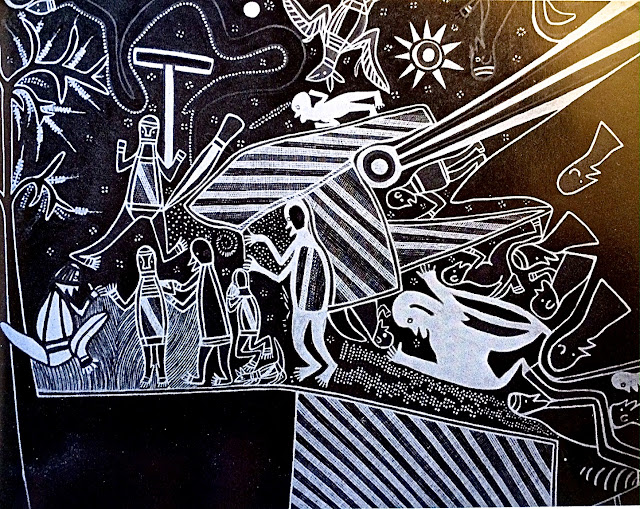Voices on the Liturgical Arts
 |
| Malanggi "Nativity" (Australia) |
This fall term I have the privilege of being on academic sabbatical. That means that I get to read more than usual. It also means that I get to follow rabbit trails with a clean conscience (within reason, of course). The rabbit trails usually, though not always, lead me to surprising discoveries, even if they are not the most immediately useful discoveries. But their worth is sometimes the possibility that you have discovered a faithful but obscure pilgrim. This pilgrim has written things--good, insightful things, witty and very particular things--that deserve a re-hearing, in some cases to a larger audience.
And that's the privilege that scholars have: to introduce readers to the obscure pilgrims and the faithful laborers who labor in fields that have not caught the attention of major publishing houses or that never stand a chance to go viral to a massive audience or whose original value was a parochial one--whether to Catholics in early twentieth-century France or to devoted readers of the Paris Review or to United Methodist practitioners of liturgical dance or to architects of church spaces across East Asia.
Here are a few of the things that have caught my attention over the past month. I find all of it immensely interesting, though only some of it will make it into the book that I am currently writing. (The tentative title of the book is, Worship and the Arts: Singular Powers and the Formation of a Human Life.) As always, my use of the term "liturgical art" is a shorthand (quite literally) for any art that occurs in the context of corporate worship.
 |
| Twelfth-century music for chanting (this example is Beneventan rather than Gregorian). |
 |
| Uknown Ghentish Master, Lactation of St. Bernard Belgian, c. 1525-1540. Ghent, Museum voor Shone Kunsten |
 |
| "We are one in Jesus our Lord" by Soichi Watanabe |
Bernard
of Clairvaux on chant (1090-1153): “Let the chant by full of gravity;
let it be neither worldly, nor too rude and poor…. Let it be sweet, yet without
levity, and, while it pleases the ear, let it move the heart…. It should not
contradict the sense of the words, but rather enhance it.”
Tim
Dowley on the Moravian Singstunden: “The
Moravian church’s distinctive worship service was the Singstunde, consisting almost entirely of hymns, with stanzas from
different hymns woven together to express the day’s theme—a ‘sermon in song’.
Zinzendorf wrote many hymns for the Singstunden,
often composing them extempore.”
Tim
Dowley on the Presbyterian Charles G. Finney (1792-1875) and the
cross-contextual experience of singing: “he selected from camp meetings
features he thought ‘worked—including the new singing style—and carried them
back into the church to manufacture ‘revivals’, so introducing customs that
have exercised a lasting effect on American worship practice. For instance, at
the front of the church, in addition to a place for the minister, a position
was allocated for the song-leader. Finney was fully aware of the potential of
music to create a suitable atmosphere, so also provided space for a choir or
vocal quartet beside the minister.”
The neither-fish-nor-fowl
context of Rachmaninov’s Liturgy of St.
John Chrysostom (1910): “The Liturgy, for unaccompanied voices, is often regarded as
insufficiently dramatic for the concert hall but too operatic for the Orthodox
Church: ‘with such music it would be difficult to pray’.”
Jeanne Murray Walker, “On Poets and
Poetry”: “A reader
doesn’t have to know the poet’s strategies in order to be delighted by poetry,
but being aware of them increases the pleasure.”
Gordon Lathrop on the multicultural
nature of Christian worship: “So today, in the renewed liturgy, we keep a revised version of the
ancient Asian Christian reworking of the Jewish Passover to become our Pascha,
or Easter, the ancient Roman (and then northern European) Christian reworking
of the pagan winter solstice has now become our Christmas, as well as the
eastern Mediterranean (and perhaps ancient Spanish) creation of Epiphany and
the ancient Egyptian and African creation of Lent.”
Mark P. Bangert on musical
intelligence as a way of knowing the world: “developmental psychologist Howard Gardiner theorized
more than thirty years ago that human beings have multiple intelligences, that
is, skills or abilities of learning, and among the six he outlines is musical
intelligence. He has concluded that musical intelligence, though appearing in a
variety of strengths, singularly provides an individual with the ability to
perceive and apprehend aspects of feeling, as well as knowledge about feeling,
that are unavailable through other intelligences.”
Peter Hammond on church architecture
(1961): “It is a
sheer waste of time to encourage the laity to co-operate with the clergy in
teaching and evangelizing and to realize that they, too, are apostles, so long
as we go on building churches which make it virtually impossible for the
ordinary Christian to play his full part in the very action which will
inevitably be normative of his understanding of his mission.”
Mary E. McGann on bodily and
non-bodily relations to music: “In many cultures, the integral connection between the
behavior involved in making music and the sound itself is clear: music and
movement are inseparable activities. In these settings, to make music is to
dance, to move. Western music, in contrast, has focused primarily on sound
itself, minimizing the inherent bodiliness of any musical communication. This
tendency is reinforced by our familiarity with radios and stereo systems that
produce sounds without apparent human agency. But, as Anthony Seeger points
out, this is an ‘auditory illusion’ and not a feature of music.” Within the
context of Our Lady of Lourdes, a Catholic church comprised of black persons,
music is meant to be “felt and not only heard.”
Julia Cameron: “Art is born in attention. Its
midwife is detail.”
Romano Guardini on raised hands
(1918): “There is
greatness and beauty in this language of the hands. The Church tells us that
God has given us our hands in order that we may ‘carry our souls’ in them. The
Church is fully in earnest in the use she makes of the language of gesture. She
speaks her innermost mind, and God gives ear to this mode of speaking.”
Walter J. Ong on the power of human
vocality: “The
centering action of sound (the field of sound is not spread out before me, but
is all around me) affects man’s sense of the cosmos. For oral cultures, the
cosmos is an ongoing event with man at its center.”
Herbert J. Levine on the liturgical
poetry of the psalms and our capacity to memorize: “Recent psycholinguistic studies
have shown that the number of words that can be retained in one’s short-term
memory is less than ten. Biblical poetry typically has lines of seven to nine
words in total, while biblical prose sentences tend to be upwards of thirteen
words. In biblical poetry, the medial break aids the memory in organizing what
it has heard into even shorter, more easily memorable units. These facts make
it quite clear that, however it was composed, biblical poetry was intended for
and is responsive to the ear.”
Ronald John Zawilla on Medieval
Christians and their view of God’s generosity exhibited in liturgical vestments: “For the ancients as well as for
medieval people, God is distinguished by a generosity that is liberal to the
point of ‘wasteful’: the cup so full that it spills over, the measure that is
packed down, shaken, and still overflows. God’s generosity, echoed in the
dedication of God’s servants, is symbolized in the amplitude of their
liturgical vesture. This generosity is an eschatological sign of what is to
come. It is a sign of the sacred play and leisure of the reign of heaven.”
Van Gogh on the practice of painting: “Although I’ll have pained the
actual painting in a relatively short time, and largely from memory, it’s taken
a whole winter of painting studies of heads and hands” (Letter #497).
Abbot Suger (inscription on the bronze doors made by Suger for the Abbey of St. Denis): "Whoever thou art, if thou seekest to extol the glory of these doors, Marvel not at the gold and the expense but at the craftsmanship of the work. Bright is the noble work; but, being nobly bright, the work Should brighten the minds, so that they may travel, through the true lights, To the True Light where Christ is the true door. In what manner it be inherent in this world the golden door defines: The dull mind rises to truth through that which is material And, in seeing this light, is resurrected from its former submersion."
Abbot Suger (inscription on the bronze doors made by Suger for the Abbey of St. Denis): "Whoever thou art, if thou seekest to extol the glory of these doors, Marvel not at the gold and the expense but at the craftsmanship of the work. Bright is the noble work; but, being nobly bright, the work Should brighten the minds, so that they may travel, through the true lights, To the True Light where Christ is the true door. In what manner it be inherent in this world the golden door defines: The dull mind rises to truth through that which is material And, in seeing this light, is resurrected from its former submersion."
Camille A. Brown, in TED talk, “A Visual History of Social Dance in 25 Moves”: “If you knew the steps, it meant that you belonged to a social group.”


Comments
Thanks for sharing this.